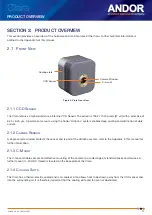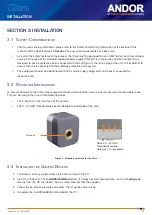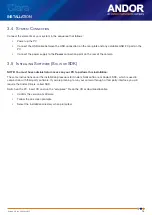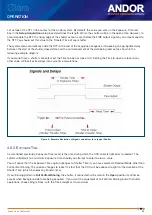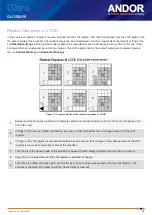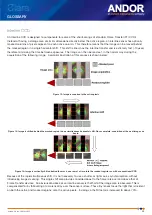
Clara
19
Version 2.0 rev 24 Mar 2015
OPERATION
Certain text boxes become active as you select each Acquisition Mode. Minimum default values are also shown in the
text boxes.
NOTE: The value you enter in one text box may affect the minimum permissible value in another text
box. The system updates the display of minimum permissible values accordingly.
Table 4: Acquisition Modes
A
cquisition
M
ode
(R
eAdout
M
ode
)
e
xposuRe
t
iMe
(
secs
)
n
o
.
of
A
ccuMulAtions
A
ccuMulAte
c
ycle
t
iMe
(
secs
)
(i
nteRnAl
t
RiggeRing
)
K
inetic
s
eRies
l
ength
o
veRlAp
*
c
osMic
R
Ay
R
eMovAl
K
inetic
c
ycle
t
iMe
(
secs
)
Single Image)
3
Single (FVB)
3
Accumulate (Image)
3
3
3
3
3
Accumulate (FVB)
3
3
3
3
Kinetic (Image)
3
3
3
3 3
Kinetic (FVB)
3
3
*NOTE: Overlap function allows data to be read out whilst exposure is underway.
4.5.2 e
xtended
iR m
ode
The Sony sensor used in the Clara offers the unique ability to switch to a mode whereby the QE of the sensor can be
increased in the Near Infrared (NIR). Sony have increased the thickness of the silicon on which the CCD is formed and by
manipulating the voltages applied to the silicon substrate, the depth of the region where red and NIR light can convert to
photoelectrons is increased.
This in turn increases the response of the sensor to these wavelengths with a QE increase from 40% to 60% at 650 nm.
For this mode to become fully active requires the first 1mS of the exposure, so it is not recommended for exposures of
less than 10 mS. In this mode the amplifier is also powered down during the acquisition, thus eliminating the effect of
amplifier glow. This mode is available in Solis by Selecting “Extended IR Mode”.
NOTE: In this mode it is not possible to read out the previous image during the exposure (overlap mode) as the
amplifier is powered down.
4.5.3
f
an
s
ettings
The speed of the cooling fan can also be controlled, useful if working in experimental configurations which are extremely
sensitive to vibration. The vast majority of applications, including optical microscopy, can be used with the default
highest fan speed, since the vibrations from the fan are minimal. However some applications can be extremely sensitive
to even the smallest of vibrations (such as when combining an optical set-up with patch clamp electrophysiology or
atomic force microscopy) and it can be useful to either select a slower fan speed, or to temporarily turn off the fan
altogether for the duration of the acquisition.
If the fan is being turned off altogether, depending on the cooling temperature selected and on the ambient temperature,
the acquisition duration can be as long as 15 - 20 minutes before temperature begins to rise. Then the fan must be
turned on again to give the head time to re-stabilize (dissipate built-up excess heat from the Peltier TE cooler) before the
next acquisition is begins.







